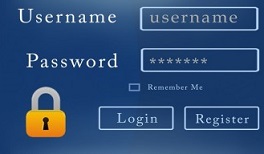If you are concerned about protecting your valuables, here are several suggestions to consider for protecting them from would-be thieves:
- Rent a safe deposit box. It may make sense to keep seldom worn jewelry, coins and other important documents in a traditional safe deposit box at your local bank. But beware if you go this route, as it is often inconvenient to retrieve your valuables, it is easy to forget what is in the box and who has the key. Plus, it’s important to fully understand your rights under the contract terms.
- Install a home safe. There are several types of in-home safes you can choose from, including wall, floor, free standing, fire and gun safes. There are also diversion safes for small items that are designed to look like everyday household objects that can blend in with its surroundings.
 Secure your house. In addition to installing a state-of-the-art home security system, there are several other ways to physically secure your home. Consider updating your locks every several years, and remember to actually use them! Many burglars are looking for easy targets, and unlocked doors and windows provide easy access. Also consider reinforcing your doors and windows, and installing motion-sensing lights both inside and outside.
Secure your house. In addition to installing a state-of-the-art home security system, there are several other ways to physically secure your home. Consider updating your locks every several years, and remember to actually use them! Many burglars are looking for easy targets, and unlocked doors and windows provide easy access. Also consider reinforcing your doors and windows, and installing motion-sensing lights both inside and outside.
Be prepared if a theft does occur
Unfortunately, thieves can still sometimes steal your valuables despite multiple layers of protection. Here are some suggestions to prepare you if any of your valuables go missing:
- Be familiar with your insurance policy. Read your insurance policy to know what items are covered. Review your policy once a year or whenever you acquire another valuable asset.
- Get an appraisal. It may be difficult to know how much insurance you need without a proper valuation of your assets. Some assets may be worth much more than you think, while other assets may be difficult to pinpoint a value without professional assistance.
- Keep a home inventory. Create a list of all your valuables that includes photographs and purchase receipts. If an asset is stolen, having this inventory always up-to-date can help quickly jump-start filing an insurance claim.
How to Shield Your Money From Inflation
 Recent high inflation rates are driving up the price for almost everything and eroding the value of your money. With varying opinions on the potential duration of the current inflation surge, it’s important to understand the causes and how you can protect your money.
Recent high inflation rates are driving up the price for almost everything and eroding the value of your money. With varying opinions on the potential duration of the current inflation surge, it’s important to understand the causes and how you can protect your money.
Possible causes of this inflation
While the root causes of inflation are not always easy to identify, the premise is simple – prices are going up for goods and services. This is often because demand is higher than supply. Here are some of the basic drivers of today’s inflation.
- The demand-pull situation. Demand for a product increases but the supply remains the same. Think of a vendor selling ponchos at a state fair. If it rains, demand is going to spike and fair-goers are willing to pay up to keep dry. This situation is rampant during the pandemic, as we all see runs on things like toilet paper and hand sanitizer. And now we are seeing pent-up demand being released, as some of the pandemic restrictions are eased. An example of this is popular vacation locations being all booked in advance.
- The cost-push situation. Demand stays constant but supply is reduced. An example of this is a lower-yield crop season when a major drought hits a region. Consumers still want their dinner salads, but lettuce is sparse. So, retailers charge more to cover their increased costs. Or when paper mills switched production to handle higher toilet paper demand, pulp used for paper and packaging had supply reductions creating a shortage which increased their prices.
- Factoring in the money supply. The more money there is available to spend (high money supply), the more the demand on all goods and services goes up. This is being manifested in wage increases as employers are having a hard time filling jobs and is also the result of many of the government spending programs during the pandemic.
Ideas to protect yourself during high inflation
- Alternative savings that is NOT cash. The value of your money sitting in your wallet or in low interest bank accounts is shrinking before your eyes. The past year has seen the highest inflation rates in the last decade at 5.4%, according to the Consumer Price Index (CPI). That means if your savings account is earning 0.6%, you’ve lost 4.8% in purchasing power over the last 12 months. Get your money to work for you by considering:
- Low risk, dividend-paying stocks
- CDs, bonds and other investments with various maturities to prepare for higher rates
- Direct lending vehicles through vetted, respected facilitators
- Investing directly in property, small businesses or other tangible assets
- Invest in yourself to learn a new trade or skill
- Lock in fixed rates on debt. Inflation can be your friend if you have a low interest, fixed-rate loan. For example, inflation will tend to increase the value of your house over time, yet your monthly payment will remain the same. So borrowing money at a low fixed interest rate, while the underlying property value increases with inflation, can be a strategy to consider.
- Delay large expenditures. Do your part to reduce demand by postponing large purchases. Consider delaying the purchase of a new car, adding to your home or taking an overseas trip until demand flattens and prices come back to a normal rate.
It’s impossible to avoid the effects of high inflation altogether, but with some smart investing and the will-power to temporarily curb spending, you can reduce inflation’s impact on your personal bottom line.
Tips for enhancing your digital privacy
Companies are following your every move. When you have a cell phone, they are tracking what apps you use, where you go, who you talk to and more! Other smart devices listen to your conversations in your home, keep track of what you view on your TV, and report where you visit and what routes you take to get there. Even worse, the more you share the greater the chance a hacker gets this information.
Consider these tips to more actively protect yourself and your information.
The power of the opt out
Apple recently introduced an opt out feature on their iPhones. Historically, when you download a new app onto an iPhone, you have to manually opt out of sharing your device’s data. Now when you download a new app on your iPhone, you’ll be asked whether you want to opt in and allow the app to have access to your information.
So, if you are an iPhone user, start with the opt out and then deliberately select who you wish to give access to your information. And opt out does not have to be global. For instance, a direction function needs your location when you use it. But it does not need to be turned on all the time.
Actions:
- Leave opt-out as default on iPhones and set default to opt-out on other mobile phone brands.
- Review all apps and turn off tracking and data sharing.
- Actively turn off your phone if you do not wish to be tracked.
- Review all smart devices and select your opt out options. Include TVs and personal assistants in your review.
Protect your web browsing
 Companies love to keep tabs on your browsing habits. And it is not just limited to their own sites. They might spy on ALL your activity. They see every website you visit, monitor all your clicks, and track all social media likes and videos you view. They then use this information to determine what you see and read. In short, they control your world view, both in content and in what ads you see.
Companies love to keep tabs on your browsing habits. And it is not just limited to their own sites. They might spy on ALL your activity. They see every website you visit, monitor all your clicks, and track all social media likes and videos you view. They then use this information to determine what you see and read. In short, they control your world view, both in content and in what ads you see.
Actions:
- Actively use ad blockers such as AdBlock and uBlock.
- Turn off cookies and periodically empty your cache.
- Avoid downloading any and all extensions unless absolutely required.
Use best data protection practices
As the internet and smart devices evolve, so do the thieves that wish to steal your identity and your financial resources. So, keep up-to-date on best data protection practices.
Actions:
- Vary passwords and user IDs. Keep track of them outside of your computer.
- Keep operating systems and software up-to-date.
- Encrypt your emails and computer hard drive.
- Keep banking information off your cell phone.
- Back up all your devices remotely.
- Use current antivirus software.
- Monitor your credit reports for any suspicious activity.
- Confirm before opening suspicious emails or attachments.
Most importantly, stay informed. In the end, the burden of protecting your data always falls on you.
 Do you know what your kids are doing online? That question may seem like it has a simple yes or no answer, but that’s hardly the case. With so many streaming platforms, social media outlets and new gaming options popping up every day, it’s nearly impossible to fully protect your kids from what they can encounter online.
Do you know what your kids are doing online? That question may seem like it has a simple yes or no answer, but that’s hardly the case. With so many streaming platforms, social media outlets and new gaming options popping up every day, it’s nearly impossible to fully protect your kids from what they can encounter online.
The Federal Trade Commission has several suggestions for protecting your kids online. Here are some of its recommendations.
- Overcommunicate. How successful you will be with your child’s online safety hinges on communication. Ask them about the newest apps and online trends. Be open about the dangers of the internet and teach them to be skeptical about every website and app. Encourage them to bring concerning items they find to you to have a discussion. The goal is to make your child as concerned about their online well-being as you are.
- Limit where and how they use their devices. Most phones, tablets and computers have parental control options that allow you to set age, time and content restrictions. Spend some time to understand what’s available to parents and how it works. It can be hard to know where to draw boundaries for your children, but don’t let that discourage you. A good practice is to start by over-restricting and then becoming more lenient over time. In addition to what your kids can access, set rules about where they can use their devices.
- Stress the safe-guarding of personal information. Most kids know not to openly share addresses, phone numbers or personal information online, but there are a few places where it happens inadvertently. One of those is in your profile you set up for a website or app. In some cases, your profile is made public to other users. Another place it can happen is in-app chatting. Most apps and games have a forum that allow users to interact with one another. Frequently ask your kids about who they are interacting with online and follow up on any suspicious online relationships. Never allow photos of your home or address to be shared or posted.
- Observe attitude and behavior. Monitor your child’s activity and let them know you are doing so. If your child is struggling with something they came across online, or have found themselves in a dangerous situation, they may show signs through their behavior. If you notice them withdrawing emotionally, looking to access devices in private, or showing signs of anxiety or depression, your kids may need your help.
Discussing the dangers of the online world with your child can be uncomfortable and awkward, but in today’s interconnected world, it’s imperative in order to keep them mentally healthy and physically safe.
The Consumer Financial Protection Bureau recently reported in financial exploitation cases that older adults lost an average of $34,200. Unfortunately, these funds are often never recovered. You can ensure this doesn’t happen by learning more about scams and how to protect yourself. Here are some tips:

- Recognize the scams.The best way to protect yourself from a scam is to understand what they look and sound like. Here are a few key elements to look for when identifying a scam:
- You are promised a great offer or benefits
- You are forced to make quick decisions
- You are pressured to provide financial and/or personal information
- You are threatened
Did you know? IRS impersonation scams are the No. 1 scam targeting older adults, according to the Treasury Inspector General for Tax Administration, with more than 2.4 million Americans targeted.
- Know why you are a target.You and other older adults may be targeted because you own a home, and have retirement savings and exceptional credit — a treasure trove for con artists to pillage. Scammers take advantage of trusting older adults because they’re less likely to say no and sometimes have cognitive issues that affect decision-making skills. In other cases, family members and non-related caregivers may have easier access to their funds, making them more susceptible to theft.
- Keep your personal and financial information safe. Keep your bank information, Social Security card and other finances stored somewhere secure in your home. Think twice about what you are sharing on Facebook, and don’t give out your Social Security or account numbers without vetting the person or company asking you for it. Con artists find useful information on social media sites about your family members and then pretend to be a relative who asks for money, or they could directly ask you for sensitive information over the phone or via email.
- Hang up if you feel uncomfortable. Don’t worry about being impolite if someone on the phone is pressuring you into sharing sensitive information. Hang up. If the call comes from a company you trust, you can call back and ask for the department that handles your account to determine if the call is for a legitimate reason.
- Turn down unsolicited offers. If you receive a call or an in-person visit from someone you don’t know selling you a product or service you didn’t request, turn it down or tell them you’ll decide at a later time. If the service or product interests you, conduct independent research on three suppliers. Proactively contact all three and determine the best offer. Include a trusted family member in the decision-making process. Doing this can effectively eliminate most scams.
- Use direct deposit. You can avoid having your checks stolen when you arrange for your checks to be directly deposited into your bank account. Ask your bank to show you how.
- Speak up if you think you’re a scam victim. There’s no need to feel embarrassed or ashamed if you think you’ve been scammed. Instead, let people know right away.
- Call your bank and/or credit card companies.
- Reset your account passwords.
- Call the police to report stolen property.
- Submit a consumer complaint using the FTC consumer Complaint Assistant.
- Report the scam by calling the United States Senate Special Committee on Aging Fraud Hotline at 1-855-303-9470.
- If you suspect elder abuse is also involved, contact adult protective services.
 According to the Association of Certified Fraud Examiners, nearly 30 percent of businesses are victims of payroll malfeasance, with small businesses twice as likely to be affected as large businesses. Here are four scary payroll fraud schemes you need to know:
According to the Association of Certified Fraud Examiners, nearly 30 percent of businesses are victims of payroll malfeasance, with small businesses twice as likely to be affected as large businesses. Here are four scary payroll fraud schemes you need to know:
- Ghost employees. A ghost employee does not exist anywhere except in your payroll system. Typically, someone with access to your payroll creates a fake employee and assigns direct deposit information to a dummy account so they can secretly transfer the money into their own bank account.
- Time thieves. Time stealing happens when employees add more time to their timecard than they actually worked. Sometimes multiple employees will team up to clock each other in earlier than when they arrive or later than when they depart for the day.
- Shape-shifting commissions. In an attempt to bump up a commission payment or attain a quota, sneaky sales employees may alter a sales contract to their benefit. A typical tactic used by a dishonest salesperson is to make a booked sale appear larger than it is and then slide a credit memo through the system in a later period. Companies with complicated commission calculations or weak controls in this area are the most vulnerable.
- External swindlers. A popular scam, known as phishing, starts with a fraudster impersonating a company executive through email or over the phone asking an employee with access to payroll data to wire money or provide sensitive information. These imposters can make the correspondence look very real by using company logos, signatures and email addresses.
Tips to combat payroll fraud
Being aware of the threats is a start, but you also need to know how to stop them. Here are some tips to reduce your company’s payroll fraud risk:
- Better internal controls. While most employees are trustworthy, giving too much control over your payroll to one person is not a good idea. Separating payroll duties and formalizing an approval process protects both your business and your employees.
- Review payroll records. Designate someone outside of the payroll-processing department to periodically review the payroll records. Have them review names, pay rates and verify that the total payroll matches what was withdrawn from the business bank account.
- Perform random internal audits. During an internal audit is when you can really get into the details to look for potential payroll fraud. You can do an in-depth review of the whole payroll system or select a random sample of dates and employees. Keep the timing of the audit under wraps to prevent giving someone the chance to cover up their misdeeds.
Managing your business payroll is a daunting task by itself, and actively protecting against fraud adds additional complexity.
 You’re doing your passwords all wrong.
You’re doing your passwords all wrong.
So says the developer of the guidelines most internet users have been following for 15 years, anyway. Passwords that L00K l!ke tHi$ are actually much more susceptible to hacking than most people realize, says Bill Burr, former manager of the National Institute of Standards and Technology (NIST) and author of the NIST’s 2003 recommendations for password management.
In an interview with The Wall Street Journal, Burr said that his previous advice to use numbers, symbols and randomized capitalization resulted in people creating passwords that are easy for computers to predict.
A more secure option is to use four random words, such as “that purple monkey dishwasher.” Such a phrase is actually much more complicated for computers to guess, The Wall Street Journal reports. (Cartoonist Randall Munroe explained the math in a comic six years ago.)
Some password advice remains relevant, however: avoid using birthdays or anniversaries, your kids’ names or your address, as all of this information is easy for hackers to locate. Additionally, use different passwords for each of your accounts and avoid storing them where they can be easily seen or stolen.
With cybersecurity threats on the rise, CPAs are paying attention to such advice. (An article about Burr’s interview that appeared in last Thursday’s CPA Letter Daily was one of the week’s most clicked stories, natch.) Strong passwords are just the tip of the iceberg, though. CPA firms and their clients are looking at ways not only to protect sensitive information, but also to report on those efforts.
In response to this need, the AICPA has updated its Cybersecurity Resource Center to provide information on protecting firms, advising clients and reporting on an organization’s cybersecurity efforts – all using the recently released AICPA cybersecurity risk management reporting framework.
Lindsay N. Patterson, CAE, Senior Manager – Communications and Public Relations, Association of International Certified Professional Accountants
Very few things in life can create a higher degree of stress and hassle than having your Social Security Number (SSN) stolen. This is because, unlike other forms of ID, the SSN is virtually permanent. While most instances of SSN theft are outside your control, there are some things that you can do to minimize the risk of this ever happening to you.
Never carry your card. Place your SSN card in a safe place. That place is never your wallet or purse. Only take the card with you when you need it.
Know who needs it. As identity theft becomes more of a problem, there are fewer who really need to know your Social Security Number. Here is that list.
- The government.The federal and state governments use this number to keep track of your earnings for retirement benefits and to ensure you pay proper taxes.
- Your employer.The SSN is used to keep track of your wages and withholdings. It also is used to prove citizenship and to contribute to your Social Security and Medicare accounts.
- Certain financial institutions.Your SSN is used by various financial institutions to prove citizenship, open bank accounts, provide loans, establish other forms of credit, and report on your credit history.
Know who really does not need it. Many other vendors may ask for your Social Security Number, but having it is not an essential requirement. The most common requests come from health care providers and insurance companies. But the request for your number may come from anyone who wishes to collect an unpaid bill. When asked on a form for your number, leave it blank. Challenge the provider if it is requested.
Destroy and distort. Shred any documents that have your SSN listed. When providing copies of your tax return to anyone, distort or cover your SSN. Remember your SSN is printed on the top of each page of Form 1040. If the government requests your SSN on a check payment, only place the last four digits on the check. Prefill the first five digits with X’s.
Keep your scammer alert on high. Never give out your SSN over the phone or via e-mail. Do not even confirm your SSN to someone who happens to read it back to you on the phone. If this happens to you, file a police report and report the theft to the IRS and Federal Trade Commission.
Proactively check for use. Periodically check your credit reports for potential use of your SSN. If suspicious activity is found, have the credit agencies place a fraud alert on your account. Remember, everyone is entitled to a free credit report once a year. You can obtain yours at www.annualcreditreport.com.
Replacing a stolen SSN is not only hard to do, it can create problems. You will need to re-establish your credit history, reassign your SSN benefits history, and realign your tax records. Your best defense is to stop the theft before it happens.
Is your company vulnerable to cyber-crime? Most computer and/or network security breaches are the result of a lack of understanding of the importance of security processes within a company. It’s important to recognize how implementing effective security procedures can protect your clients’ privacy, guard against misuse of confidential information and benefit your business. Here are some suggestions:
- Establish and maintain best practices for computer security.
- Make sure that each system user has a unique login.
- Grant system permissions to users as needed.
- Protect all networks and hardware against viruses.
- Monitor system activity.
- Run regular backups.
- Educate employees on passwords – creating strong passwords and not sharing their passwords.
- Prohibit employees from opening email attachments (particularly ZIP files) from unknown or suspicious sources.
- Disable access to the network and all cloud solutions for former employees.
Setting up and following these simple suggestions can help keep your company and its reputation safe and secure!
Imagine this – you’ve given us all your documents early, we’ve prepped and processed your tax return, you’ve reviewed it and signed the eFile forms… then we call you and advise you that your tax return rejected eFiling because someone has already filed using your social security number! Sadly, this can happen if you become one of the growing number of victims of tax return identity theft. At least one estimate shows tax-related identity theft cases have increased 650% since 2008. Identity theft can delay your tax refund, but other consequences could be credit card debt or loans taken out in your name.
To avoid becoming a victim, we recommend the following:
- Safeguard your social security number and other financial information. Don’t send financial documents via email unless you use an encryption program. To send documents to us, use our LeapFile application to securely send us documentation.
- Check your bank and credit card transactions regularly and monitor your credit ratings.
- Don’t give out your information on the phone, even if the caller identifies themselves as an agent of the IRS or other authorities.